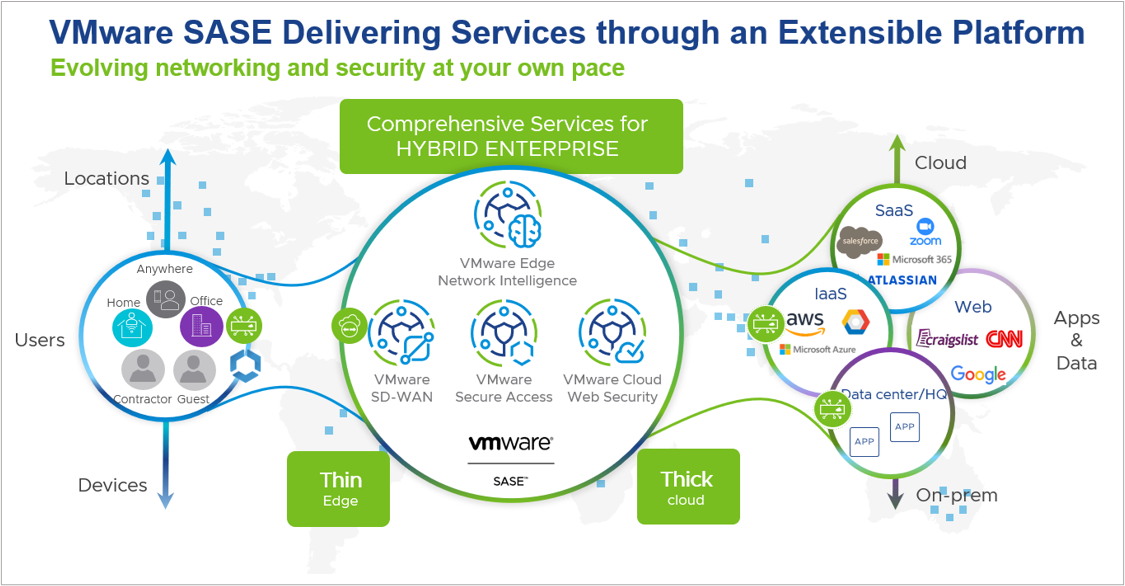VMware SD-WAN integrates with IBM QRadar SIEM to enable organizations with comprehensive cloud-enabled security, in addition to optimized connectivity.
General Overview
The cybersecurity landscape is constantly changing, with new threats emerging all the time. Cybercriminals can use different methods to attack, such as malware, ransomware, phishing attacks, and denial-of-service attacks. Cloud computing, mobile devices, and IoT endpoints have also created new ways for cybercriminals to attack.
Remote work has made it harder for organizations to protect their data and systems from attack. Employees working from home often use home networks that may not be as secure as the corporate network. They access corporate resources from these networks, which increases the risk of attack.
Integrating SIEM (Security Information and Event Management) platform with VMware SASE can help organizations monitor all traffic, no matter where it comes from, and quickly detect and respond to threats. VMware SASE provides a single point of control for all network traffic, including traffic on the public internet. SIEM can collect and analyze this traffic for signs of malicious activity.
By integrating SIEM with SASE, organizations can get a better view of their network traffic and spot threats faster. This can help them protect their data and systems from attack and improve their overall security posture.
This document will explain the technical aspects of integrating VMware SD-WAN and SASE with IBM QRadar SIEM. This will help organizations use VMware SASE capabilities faster and integrate them with their existing security ecosystem.
VMware SASE Overview
VMware SASE is a cloud-based security platform that offers a unified way to access applications and data securely, no matter where they are. SASE combines several security technologies, such as Secure Web Gateway (SWG), Cloud Access Security Broker (CASB), and Zero Trust Network Access (ZTNA), into one easy-to-manage platform.

You can deploy VMware SASE in diverse ways, such as a cloud-delivered service, a software-only solution, or a hybrid solution. This flexibility makes it a good option for organizations of any size and IT maturity level.
Some of the benefits of VMware SASE include:
- Simplified security management: VMware SASE gives you a single place to manage your security policies and settings. This can help you reduce the complexity of your security infrastructure.
- Improved security posture: VMware SASE combines several security technologies to provide a comprehensive security approach. This can help you protect your organization from various threats.
- Increased agility: VMware SASE is a cloud-based solution, so you can easily scale it up or down as your needs change. This can help you be more agile in responding to changes in your business environment.
IBM QRadar Overview
IBM QRadar is a security information and event management (SIEM) solution that collects, analyzes, and correlates security data from various sources. This data can include logs, network traffic, and security alerts. QRadar uses this data to identify and respond to security threats and comply with industry regulations.
QRadar is a robust and scalable solution that organizations of any size can use. It is also a cloud-based solution, which you can easily deploy and scale to meet your organization's needs.
Some of the key features of IBM QRadar include:
- Data Collection from multiple sources: QRadar can collect data from various sources, such as firewalls, intrusion detection systems, and web proxies. You can use this data to identify and respond to security threats.
- Data Correlation: QRadar uses machine learning and artificial intelligence to analyze and correlate data. This lets QRadar find patterns and anomalies that may indicate a security threat.
- Threat Response: You can use QRadar to respond to security threats. This can include automatically blocking malicious traffic, sending alerts to security analysts, and taking other actions to stop threats.
- Regulatory Compliance: You can use QRadar to help your organization comply with industry regulations. This can include PCI DSS, HIPAA, and SOX.